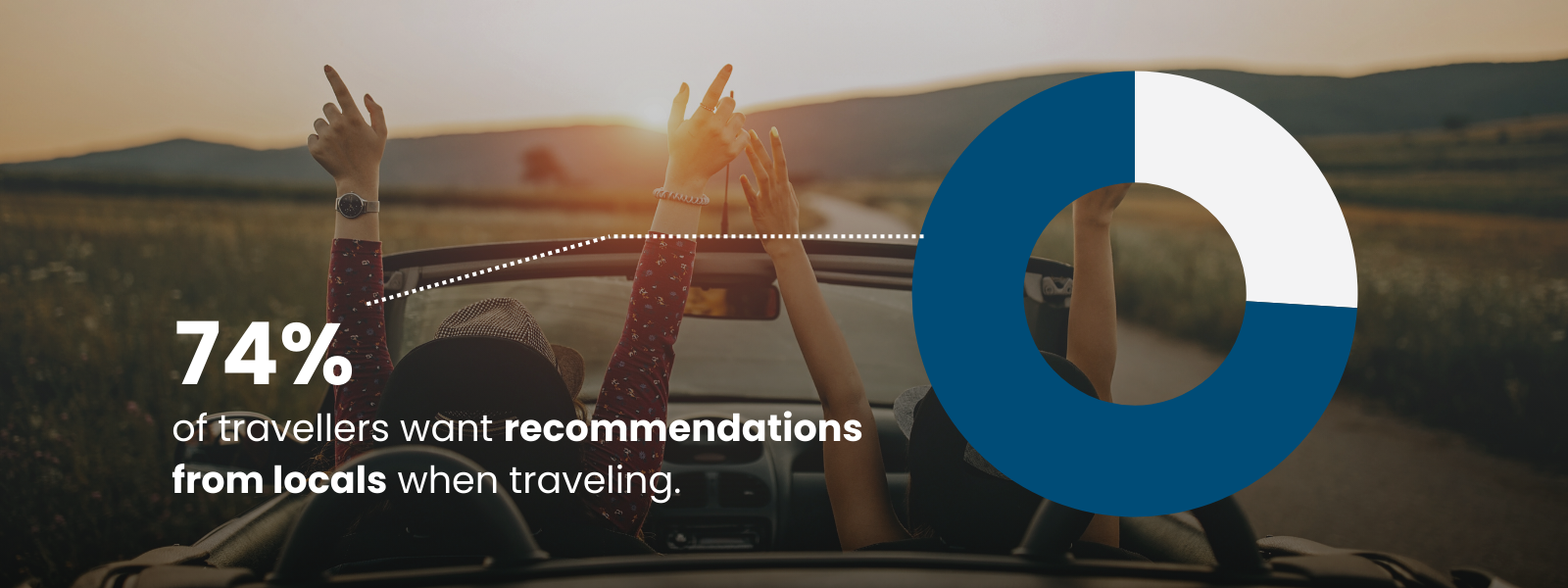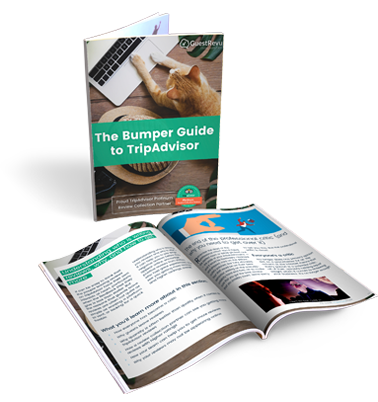The days of generic, one-size-fits-all travel marketing are over. Instead, catering to specific tourism niches is the perfect way to attract the right guests and gain those all-important direct bookings. In today's evolving travel landscape, understanding the diverse needs and preferences of travellers is crucial for hotels to attract and retain loyal guests.
In this article
1. The Adventure Seeker
A growing segment of travellers aren’t going on holiday for relaxation – they’re looking for an action-packed itinerary and full adventure experiences, often the more thrilling the better. These adventure-seekers are drawn to destinations that offer outdoor activities like hiking, biking, climbing, and water sports, and are often also on the lookout for off-the-beaten-track cultural experiences, immersive excursions and going where no traveller has gone before.
A quick and easy way to cater to this 406.12 billion dollar market is by partnering with local adventure activity providers. If you’ve got the resources, it’s not too difficult to dip your toe in the adventure pool by providing gear rentals or offering guided tours to local sites.
To earn more bookings from these adrenaline-hungry adventurers, you need to make an intentional effort to communicate the activities available around your hotel, and, ideally, that your team can handle all of their excursion bookings and arrange their itineraries.
You don’t necessarily need to have all the activities on-site, but a few complimentary amenities (like secure storage for guests’ own equipment, or pre-packed breakfasts for ultra-early risers) and clear messaging that emphasises your amenities, proximity to natural sites and relevant add-ons are what will make your hotel a desirable option for these adventure-loving guests.
Take a look at 5 hotels that take guest experiences to the extreme
.png?width=1600&height=600&name=Adventure%20(1).png)
2. The Wellness Traveller
The Global Wellness Institute (GWI) defines wellness tourism as “travel associated with the pursuit of maintaining or enhancing one’s personal wellbeing”. These wellness seekers are looking to improve their health and wellbeing during their next vacation. An article by researchers at Łódź University found that the post-COVID wellness tourism sector represents one of the fastest-growing tourism market segments globally. In addition to this sector's rapid growth, wellness travellers tend to spend much more per trip than travellers from other tourism sectors, even though they tend to travel solo or in pairs.
Covering such a broad spectrum of activities and amenities, it can be difficult to pinpoint exactly what attracts wellness travellers. Some seek hotels with spa facilities, fitness centres, healthy dining options, and opportunities for meditation or yoga. But the market is expanding rapidly and changing as guests experiment with what it means to be “well” – some of the newer wellness offerings include sleep tourism, vegan retreats and in-room fitness offerings.
Gearing up for wellness guests doesn't have to include a complete overhaul of your property – sometimes just adding healthy or vegan options to your menu or providing guests with unique amenities that enhance the inherent wellness of a relaxing holiday can attract this segment without costing your property a significant outlay. This article explores some of the ways you might already be positioned to tap into the wellness travel market.
If you want to make this segment a core target market, you can offer wellness retreats in-house or collaborate with local wellness experts to offer specialised treatments, workshops, or retreats from your property.
Whatever wellness avenue you choose to pursue, make sure that the holistic, relaxing and uplifting benefits are clearly communicated through your property's marketing efforts and take centre stage on your website.
.png?width=1600&height=600&name=Wellness%20(2).png)
3. The Slow Traveller
Travel can so often involve hectic schedules where guests rush from place to place to visit as many attractions as humanly possible, queueing up with a herd of other tourists to take some photos, and, with just that glimpse of the local scenery, packing up and heading off to the next destination on their list.
Slow travel challenges this idea of tourism, allowing guests to spend more time immersing themselves in the destination they visit for more fulfilling travel experiences within the community. Slow travel doesn't necessarily mean longer holidays (although some people do choose this option) but is rather about the intentional, conscious and conscientious experience of a place and its culture.
These guests want to fully immerse themselves in the local community, its customs, history, foods and music. The best way to attract these travellers is by offering lots of information on your local area, things to do and see, off-the-beaten-track experiences and even offering dishes from locally sourced produce. You can go further by offering cultural tours, partnering with local museums and galleries, and providing information about local events and festivals.
As a hotelier, it’s important to connect with your own local community to fully understand and be able to recount all of the hidden gems and one-of-a-kind stories from your area to your guests. Collaborating with the community means you can offer a wider variety of amenities and experiences, catering to a wider variety of tastes.
Catering to slow travel is often very rewarding for hoteliers, as these guests are more often than not delighted by their experience and it’s these guests who have become part of the community, who will recommend their trip and the unique places and people they met to their friends and family.

4. The Wandering Worker
From digital nomads who work remotely and travel alone for extended periods, to corporate travellers who bring a partner or children along on a business trip for a ‘workation’, many travellers don't balance work and life, but blend it. Plus it’s more common than you may think, 41% of employees surveyed were interested in combining business with leisure according to Statistia.
Generally, they do not have many out-of-the-ordinary needs aside from the obvious good quality wifi and a space to work, but offering comfortable co-working spaces, flexible check-in/check-out options and long-stay discounts can help attract this segment. Having a desk or space to work in their room, access to plug points and various adapters for their multiple electronic devices, and service options such as in-room dining, meeting room or conference venue bookings and flexible housekeeping can also all make these guests happier.
A key differentiating factor between these bleisure travellers and purely corporate guests, however, is that it's not all about work for them. Delight them by making it easy to incorporate fun excursions, sightseeing or cultural activities, and facilitating fun for non-working members of the party by offering spa treatments for adults and supervised activities for children.

5. The Travelling Family
Family-friendly, kiddie-inclusive offerings are a staple of the travel market for a reason – families enjoy spending time together on holiday, many families, in fact 46% percent of American families were ‘very likely’ to take a family trip soon. They are also a group that is spoilt for choice, though, and getting ahead of the pack means being clever about how you cater to the needs of the individual family members and the group as a whole.
At a bare minimum, you should offer child-friendly spaces like children's pools, game rooms, and playgrounds to keep children entertained. If you have enough demand, you could delight the adult guests by offering supervised children's activities so that they can have a few hours off duty.
Alternatively, you could ensure that your facilities cater to both the wants of parents and the whims of children simultaneously. Restaurants typically do this by providing a kiddies' menu and colouring-in kits to keep children entertained and fed while parents enjoy a meal, but this principle can be extended to most aspects of hospitality.
For example, I recently visited a spa hotel with my children. Including them in the experience by giving them their own complimentary towelling gowns and allocating a time when the indoor pool and sauna area was open to children meant that the hotel successfully delighted all the guests in room 229.
To further appeal to this massive market, curate packages that include family activities, discounts, or complimentary services. You could even collaborate with local attractions like zoos, aquariums, or amusement parks to offer discounted tickets or special packages.

6. The Eco-Conscious Traveller
Eco-conscious travellers prioritise sustainable practices and support local communities. They want to be able to continue their ‘green’ way of life while travelling and to ensure that they do not harm the environment or the local community by vacationing in a particular place. This type of traveller is not one to be ignored. While not everyone feels the need to completely change their future travel plans in deference to the natural world around them, it is a fast-growing area of concern for the majority of travellers. In fact, according to the Booking.com Sustainable Travel Report “75% of global travellers say that they want to travel more sustainably over the next 12 months, and (43%) would feel guilty when they make less sustainable travel choices”.
Hotels can attract the eco-conscious traveller by becoming an eco-conscious hotel and, a crucial step that many hoteliers forget, communicating this in marketing materials. On a theoretical level, being eco-conscious means understanding the impact that each facet of the property has on the local environment, the broader environment and your local community as a whole.
On a more practical level, this could include strategies such as implementing sustainability practices, such as using energy-efficient appliances, low-flow showers, educating guests on reusing linen and towels or reducing waste by engaging in rigorous recycling practices or making use of reusable toiletries. Amenities can have an impact on both your guest experience and the environment, and many hotels are now opting for biodegradable, non-toxic toiletries, bamboo linens, tooth brushes or locally-crafted soaps, toiletries and other amenities.
Get started with the basics of going green
While all aspects of the hotel can be influenced by the green movement, one department stands out above the crowd: the food and beverage department. Food miles have become a common term when talking about the distance that food has to travel before it’s consumed. Many green hotels have adopted the strategy of purchasing food from local suppliers, reducing the carbon footprint of obtaining the food but more than that it supports the local community and often allows for more scrutiny with what is being purchased, such as finding free-range or organic produce which further enhances the green status of the property.

7. The Lone Rangers
Solo travellers are an increasingly significant demographic in the hospitality industry, no longer fitting the outdated stereotype of those who travel alone out of necessity. Instead, many are choosing solo adventures for the freedom to explore at their own pace, focus on personal well-being, or extend business trips into leisure experiences. With a rise in solo travel bookings and growing demand for accommodations that cater to independent travellers, it’s clear that this trend is here to stay.
In one American Express report, solo travel is shown to be a major trend among young travellers, with 76% of Millennials and Gen-Z planning solo trips this year. However, their trips may be shorter than the average family stay or multigenerational holiday, with the same survey revealing that “57% of respondents agreed that they were more likely to travel solo for a quick weekend getaway than for a longer or more expensive trip.”
The Hilton 2025 Trends Report, which surveyed 13,000 travellers, has since coined the term, MeMooners, those who are taking themselves on a trip of self-reflection, well-being or new and exciting adventures. The results were quite astounding: “Nearly 50% of global respondents often travel by themselves (47%). Gen Z (55%) and Millennials (51%) are more likely to often travel on their own.”
To attract solo travellers, hotels need to offer experiences that align with their unique needs. Eliminating single supplements in favour of solo-friendly packages, which cater specifically to those travelling on their own. People travelling alone also need an extra level of security, providing secure accommodations with well-lit entrances and 24/7 reception or offering a secure bag drop point can help single people feel that both themselves and their belongings are safe.
Tim Hentschel, CEO of HotelPlanner, agrees: “The appetite for solo travel isn’t slowing down.” He mentioned that this new contemptment with being alone has stemmed from the pandemic but there are other reasons why solo travel has increased in recent years “The solo travel boom is also being driven by digital nomads—another form of travel bolstered by the pandemic which offered newfound freedom from the office with hybrid working.”
Incorporating social spaces can make all the difference, creating common areas where solo travellers can relax, or socialise with other guests can help them meet other guests. Hoteliers can take this concept further by organsing social events, ideas such as game nights, movie nights or group tours can all provide pockets of interaction and fun for single guests.
These elements were highlighted in the Hilton report, where it was noted that “44% of MeMooners appreciate suggested activities or events where they can meet other solo travellers. They also prioritise friendly team members (43%) and safety-focused amenities (41%).”
Whether they’re seeking solitude or social connections, solo travellers appreciate hotels that provide flexible, comfortable, and engaging environments. Simple changes, such as highlighting solo-friendly experiences on a hotel’s website or offering tailored packages, can go a long way in making solo guests feel welcomed and valued.

8. The Luxury Traveller
Once defined by opulent hotels, gourmet cuisine, and premium travel experiences, luxury travel has evolved significantly in recent years. Wealthy travellers are now seeking more unique, once-in-a-lifetime and adventurous journeys, such as space exploration and deep-sea expeditions, high-end experiences that go beyond just five-star accommodation.
McKinsey defines the luxury traveller as someone who spends at least $500 per night on accommodation, and according to their report, “Demand for luxury tourism and hospitality is expected to grow faster than for any other industry segment.”
This is partly due to the rise in aspiring luxury travellers: a subset of slightly younger well-to-do travellers who, although they don't necessarily have the same budget as the mega-wealthy, are still willing to spend their hard-earned money on luxury experiences.
Luxury travellers prioritise personalised service, privacy, and unique, once-in-a-lifetime opportunities. This demographic is usually older, and often includes high-net-worth individuals, business executives, and affluent leisure travellers who expect impeccable attention to detail, seamless convenience, and curated experiences tailored to their tastes.
To appeal to luxury travellers, aside from the obvious high-quality accommodations, premium bedding, and upscale amenities like swimming pools, spas, and fitness centres. Hotels should also offer bespoke services such as private butlers, VIP transfers, and personalised itineraries. Exclusive experiences, such as private dining with renowned chefs, wellness retreats, and tailored cultural excursions, add significant value. High-end technology, sustainability initiatives, and loyalty perks also enhance their experience. Ultimately, delivering flawless service, exclusivity, and a sense of prestige will ensure repeat visits and strong brand loyalty.

9. The Traveller on a Budget
Budget-conscious travellers prioritise affordability when searching for their next getaway. Often, these travellers choose to travel locally, but not always. Price-conscious travellers can still enjoy the experience of halidaying abroad, but choose to stay in more budget-friendly accommodation or look for vacation packages which offer all-inclusive deals. Hotels can attract them by offering competitive rates, budget-friendly packages, or even offering ‘unbundled’ deals.
Hotels and experience providers have learnt a thing or two from the airline industry by offering more personalised and flexible pricing options. By ‘unbundling’ their existing offers, they can allow guests to choose what they want, and are happy to pay more for, and opt out of the things they don't need.
According to a survey conducted by Oracle and Skift, nearly 90 per cent of consumers are either enthusiastic about or open to the concept of unbundling, with 43.3 per cent of consumers saying they would be very likely to book a hotel that allowed them to pay for only the amenities they use. While this is beneficial in attracting guests looking to save a few bucks, it can also be lucrative for the hotelier.
Trends in their guest feedback will allow managers to understand what their core group of guests are looking for, and the add-ons guests value most. Hoteliers can also make use of pre-stay surveys to better understand what their guests expect, and use all this information to upsell to ‘unbundled’ guests.
Another option is for hotels to offer various discounts or seasonal packages. For example, special rates in the off season, or for large groups and extended stays. Although it’s the exact opposite of unbundling, all-inclusive is back in vogue. For travellers on a tight budget, knowing exactly what the holiday will cost is a huge perk. You don't have to have all the facilities on site yourself either – work with nearby restaurants to bulk-buy meal vouchers up-front at a discount, and include these in your packages, or work with local activity providers to give your guests an unforgettable itinerary they can afford. Cleverly curated packages in partnership with other local businesses have the same benefit of allowing the traveller to budget effectively, and the additional perk of giving them the diverse, authentic experience that traditional all-inclusive resorts lack.

10. The Foodie Traveller
Foodies are passionate about cuisine in all its forms, from street food to fine dining, and are keen to explore the culinary identity of the local areas they visit. For them, food is an activity, a cultural experience, and often the highlight of their trip.
Food photos are (still) in – make your hotel’s dishes picture perfect
Beyond enjoying delicious meals, foodie travellers are curious about the stories behind the dishes. They want to learn about local ingredients, traditional cooking methods, and the people who grow, forage, or prepare the food. Many seek out cooking classes, farm visits, and food festivals that offer a deeper understanding of the region's culinary roots. Sustainability is often important to them too; they’re drawn to hotels that prioritise local sourcing and eco-friendly practices.
Hotels can appeal to this high-value demographic in many ways, most of which will enhance the experiences of less food-centric visitors as well. Partnering with local chefs or culinary schools to offer cooking workshops or chef’s table experiences can be a huge draw. Curated food and wine tours, visits to local markets, and farm-to-table dining options are also great ways to connect with these guests. Even simple touches, like welcome treats made with local produce or in-room guides to the best local eateries, can go a long way towards creating a memorable stay.

Understanding your traveller
By identifying your most valuable guest segments, you can tailor your services, communications, and experiences to better meet their expectations.
Guest feedback can help take the guesswork out of this by showing you who you’re already doing well with, and where there’s room to grow. It’s all about being more intentional with how you connect with your guests and making sure your hotel stands out for the right reasons.




